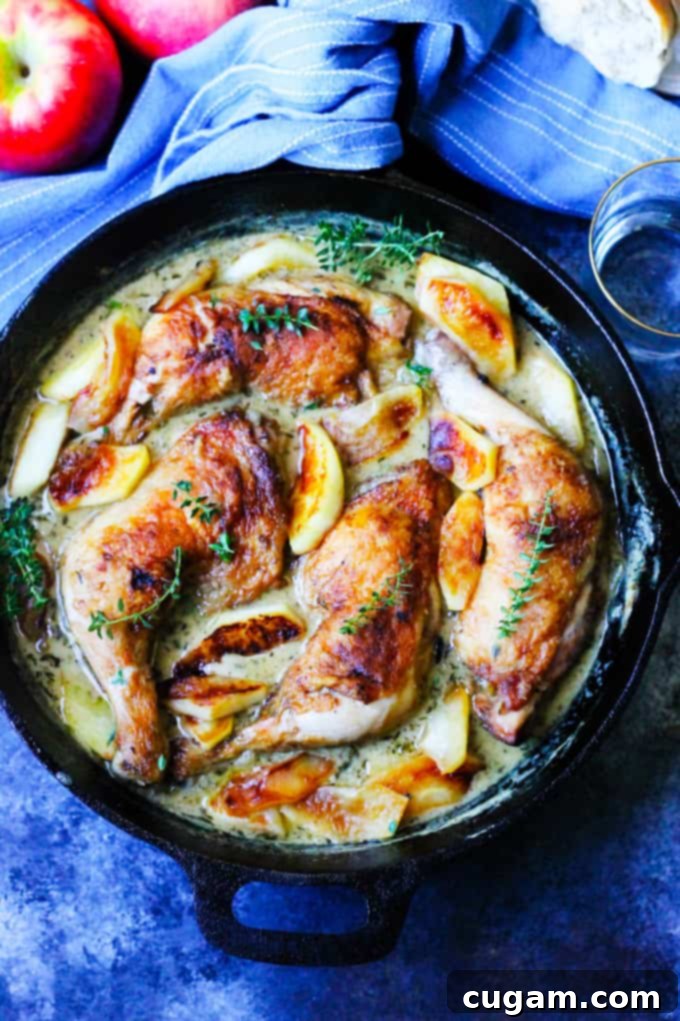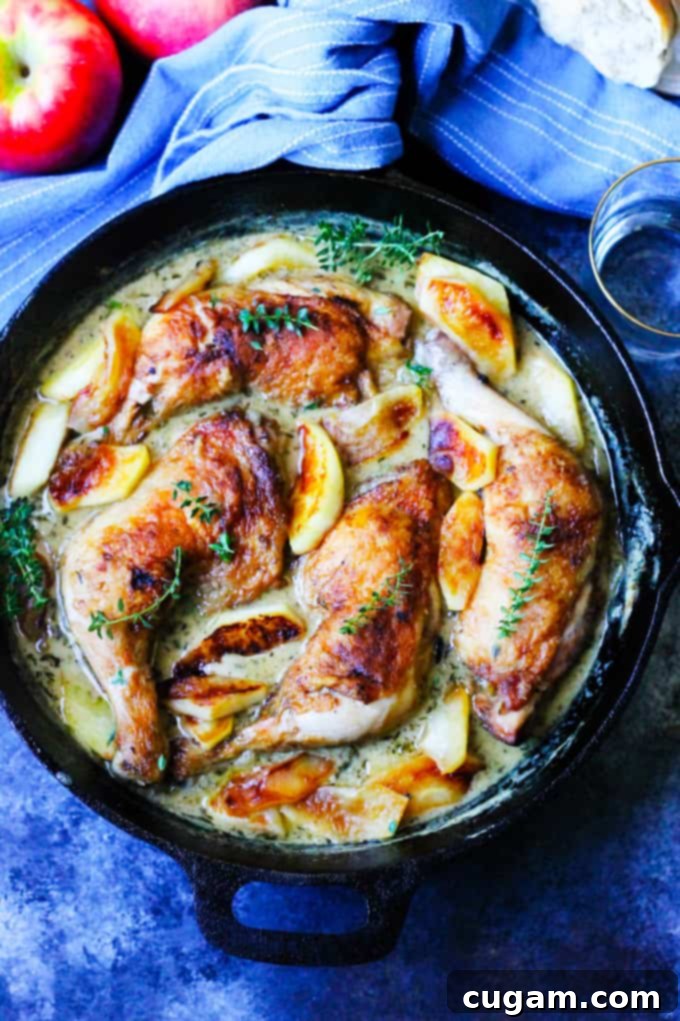Chicken Normandy: An Exquisite French Classic with Apple Cider & Brandy (Poulet à la Normande)
Chicken Normandy, affectionately known as ‘Poulet à la Normande’ in its homeland, is a truly magnificent French chicken dish that perfectly embodies the rich culinary traditions of the Normandy region. This luxurious, yet surprisingly simple-to-make, recipe features tender, whole chicken legs braised to perfection in a flavorful blend of apple cider and fine brandy. The dish is further elevated by sautéed onions, aromatic garlic, and savory herbs, all culminating in a creamy, Dijon mustard-infused sauce, beautifully complemented by sweet, fried apples. It’s a dish that not only looks impressive but delivers a “wow” factor in every single bite, making it an ideal choice for a special autumn dinner or any occasion when you desire a touch of French elegance.
Should you find yourself captivated by the allure of classic French chicken preparations, you might also enjoy exploring other delightful recipes such as this Chicken Chasseur (French Hunter’s Chicken) or the aromatic Chicken Provencal with Shallots and Garlic, each offering a unique taste of France.
Understanding Chicken Normandy: A Taste of France’s Rich Region
Chicken Normandy, or its authentic French designation Poulet à la Normande, is a renowned culinary masterpiece that hails from the picturesque northern region of France – Normandy. This area is celebrated globally for its lush orchards, especially its apples, which are the backbone of its famous apple cider and exquisite apple brandy, known as Calvados.
This recipe proudly incorporates these signature Norman ingredients, crafting a unique and deeply satisfying flavor profile. Traditionally, Chicken Normandy calls for apple brandy or Calvados, which imparts a distinct fruity and oaky note. However, if authentic Calvados isn’t readily available, any good quality brandy will serve as an excellent substitute, still contributing to the dish’s sophisticated character.
The preparation involves carefully searing the chicken to achieve a beautifully golden and crispy skin, locking in its juices. It’s then gently nestled into a rich, aromatic liquid, created from sautéed onions, brandy, and apple cider. The chicken then slowly braises in the oven, becoming incredibly tender and infused with the complex flavors of the sauce. The grand finale involves enriching the sauce with cream and serving the dish alongside perfectly fried apples, adding a touch of sweetness and textural contrast.
This dish is an absolute dream for a fall or winter dinner. I vividly recall the first time I served this famous Chicken Normandy to my husband; he was utterly speechless after his initial bite, a testament to its profound deliciousness and comforting appeal.
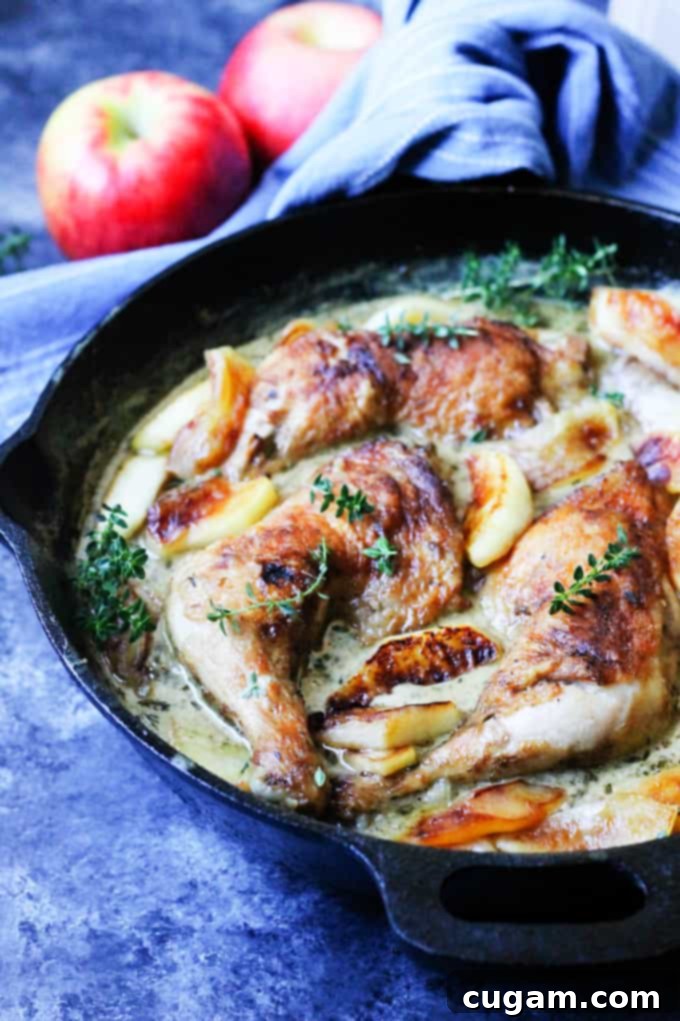
Choosing the Ideal Chicken Cuts for Authentic Chicken Normandy
For this traditional Chicken Normandy recipe, I wholeheartedly endorse the use of whole chicken leg quarters. These cuts, comprising both the thigh and drumstick, are exceptional for several reasons. They are inherently more flavorful due to the bone and skin, and their robust structure allows them to withstand the slow braising process beautifully without drying out, resulting in incredibly tender and juicy meat. The skin also crisps up wonderfully during the initial sear, adding a delightful textural element that is essential to the dish.
While whole leg quarters are highly recommended, you do have some flexibility. You could opt for just chicken thighs or a combination of thighs and drumsticks. However, if you choose these smaller cuts, be mindful of your cooking time, as they will cook faster than whole leg quarters. I suggest checking the internal temperature after approximately 20 minutes of braising in the oven to ensure they are cooked through but not overdone.
I truly believe that using chicken on-the-bone is pivotal to the incredible depth of flavor in this dish. The bones contribute collagen and marrow, enriching the braising liquid and making the sauce exceptionally savory. Nevertheless, if your preference leans towards boneless, skinless chicken thighs or even chicken breast, you can certainly use them. Just be prepared for a slightly different texture and adjust cooking times accordingly. Boneless cuts will require significantly less time to braise – check them after 15 minutes. Additionally, they will need less time to sear initially, so keep a close eye on them during that stage to prevent overcooking.
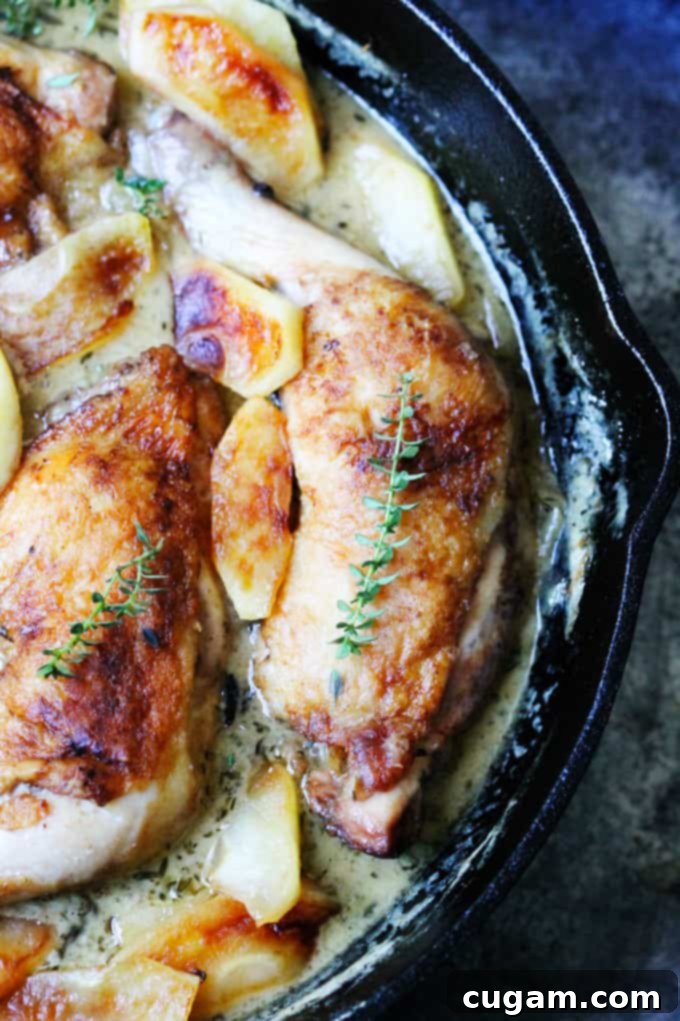
Essential Ingredients for Your French Chicken Normandy Dish
Crafting this exquisite French Chicken Normandy requires a selection of high-quality ingredients that truly shine in their simplicity. For precise measurements, please refer to the detailed recipe card below. This section is designed to guide your grocery list and explain the role of each component:
- Chicken Leg Quarters: As discussed, bone-in, skin-on leg quarters are preferred for maximum flavor and tenderness through braising.
- Butter: A cornerstone of French cuisine, butter is crucial for frying the apples, searing the chicken, and building a rich flavor base for the sauce. Unsalted butter allows you to control the seasoning.
- Sweet Onions: Sliced sweet onions provide a foundational sweetness and aromatic depth to the braising liquid, caramelizing beautifully.
- Garlic: Minced garlic adds a pungent, savory layer that complements the other aromatics and liquids.
- Dry Thyme: This classic herb infuses the dish with an earthy, slightly floral note that is quintessential to French cooking.
- Apples: Choose firm, crisp apples that can maintain their texture during frying and braising. Honeycrisp is an excellent choice, offering a balanced sweetness. Granny Smith can also work, providing a tarter contrast.
- Brandy (ideally Apple Brandy or Calvados): This spirit is central to the dish’s Norman identity. Calvados, an apple brandy from Normandy, offers the most authentic flavor. If unavailable, any good quality brandy will contribute depth and complexity.
- Apple Cider: VERY IMPORTANT: Do not confuse this with Apple Cider Vinegar! We need natural, unsweetened apple cider (often labeled “cloudy apple juice” in some regions) to provide the fruity, slightly tart base for our braising liquid. It’s key for deglazing and infusing flavor.
- Dijon Mustard: A spoonful of Dijon mustard adds a tangy, slightly sharp counterpoint to the richness of the cream and brandy, helping to emulsify and thicken the sauce.
- Heavy Cream: This transforms the braising liquid into a luxuriously smooth, velvety sauce, adding richness and body.
- Fresh Thyme: Added at the end, fresh thyme brightens the dish with its vibrant aroma and adds a lovely visual garnish.
- Seasoning: Simple salt and freshly ground black pepper are essential to enhance all the flavors.
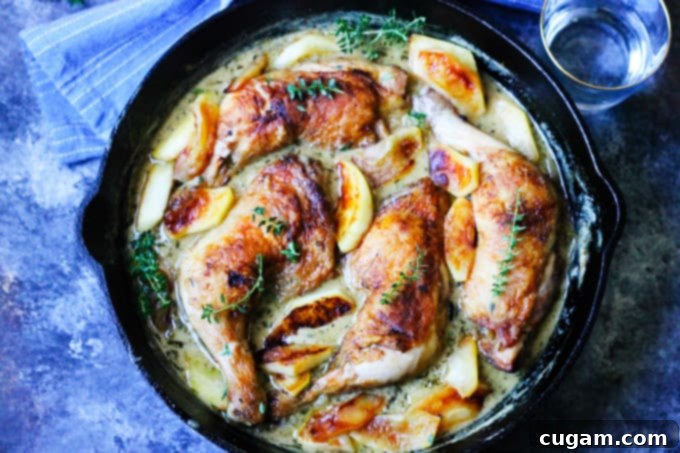
Mastering Chicken Normandy: A Step-by-Step Guide
For a printable recipe with exact measurements, precise cooking times, and detailed nutritional information, please scroll down to the comprehensive recipe card below. This section is designed to provide a visual and descriptive walkthrough of creating this incredible Chicken Normandy dish.
Step 1: Perfectly Fry the Apples. This initial step is key to building flavor. You could fry the apples in a separate pan while the chicken braises, but I prefer to use the same skillet you’ll use for the chicken. This allows the apples to absorb some of the residual chicken flavor later. Begin by peeling your chosen apples, quartering them, removing the seeds, and then slicing them into even wedges. Heat a generous amount of butter in your skillet over medium heat. Arrange the apple slices in a single layer, ensuring they don’t overcrowd the pan. Fry them until they turn beautifully golden brown on each side, flipping a few times to ensure even cooking and caramelization. Once perfectly cooked, gently remove the apple slices from the pan and set them aside on a plate; they will be reintroduced later.
Step 2: Sear the Chicken for Golden Perfection. After removing the apples, add a bit more butter to the same pan. Generously season your chicken leg quarters on both sides with salt and pepper, then lightly sprinkle them with flour. This flour will help create a beautiful crust and also contribute to thickening the sauce later. Place the seasoned chicken, skin-side down, onto the hot pan. Sear for 5-7 minutes per side, or until the skin achieves a deep, crispy golden-brown hue. This searing step is crucial for developing rich flavor through the Maillard reaction. Once seared to perfection, remove the chicken from the pan and set it aside with the apples.
Step 3: Prepare the Aromatic Braising Liquid. Preheat your oven to 375ºF (190ºC). Return to the same pan – there should be a delicious layer of browned bits (fond) from the chicken and apples, which is crucial for flavor. Add your sliced onions to the pan. EXPERT TIP: If you used bone-in, skin-on chicken, enough fat should have rendered, so you likely won’t need more butter. However, if you chose leaner cuts like boneless chicken breast or skinless thighs, you may need to add a tablespoon of butter before sautéing the onions. Sauté the onions over medium heat for approximately 5-7 minutes until they soften and become translucent. Next, add the minced garlic and dry thyme, cooking for just another minute until fragrant. Now for the deglazing: pour in the brandy and scrape up all those flavorful browned bits from the bottom of the pan. Let the brandy simmer until about half of it has evaporated, concentrating its flavor. Finally, pour in the apple cider (remember, the cloudy apple juice, not vinegar) and allow it to cook for about 5 minutes, letting the flavors meld.
Step 4: Braise the Chicken to Tenderness. Carefully place the seared chicken back into the skillet, ensuring the skin side is facing up to maintain crispness. Cover the pan tightly with a lid or aluminum foil and transfer it to your preheated oven. Allow the chicken to braise for approximately 30 minutes. This slow cooking in the flavorful liquid is what makes the chicken incredibly tender and juicy. Once the braising time is complete, carefully remove the pan from the oven using heavy-duty oven mitts. Please be extremely cautious: the handle of the skillet will be incredibly hot. I’ve made the mistake of forgetting this and burning myself. EXPERT TIP: To prevent accidental burns, keep one oven mitt on until your dish is entirely finished and moved to a cool surface. This visual cue will help you remember the pan is still hot.
Step 5: Perfect the Velvety Sauce. Once the chicken is out of the oven, gently remove the chicken pieces from the skillet and place them on a separate plate to rest while you finish the sauce. Return the skillet with the braising liquid to the stovetop over medium heat. First, stir in the heavy cream, blending it thoroughly into the liquid. Next, add the Dijon mustard, mixing well to ensure it’s fully incorporated. Allow the sauce to simmer for about 5 minutes, stirring occasionally, until it thickens to a luxurious, rich consistency. Finally, return the reserved fried apples and the fresh thyme to the skillet. Gently nestle the braised chicken back into the sauce, allowing it to soak up some of that exquisite flavor before serving.
Step 6: Serve and Savor. To present this magnificent dish, spoon a generous amount of the creamy, apple-infused sauce onto each plate. Ensure that each serving includes a good portion of the tender onions and caramelized apples, as they are integral to the dish’s flavor and texture. Place one of the succulent chicken leg quarters directly on top of the sauce. Serve immediately and prepare to enjoy the rich, complex, and utterly satisfying flavors of this classic French masterpiece. Bon appétit!
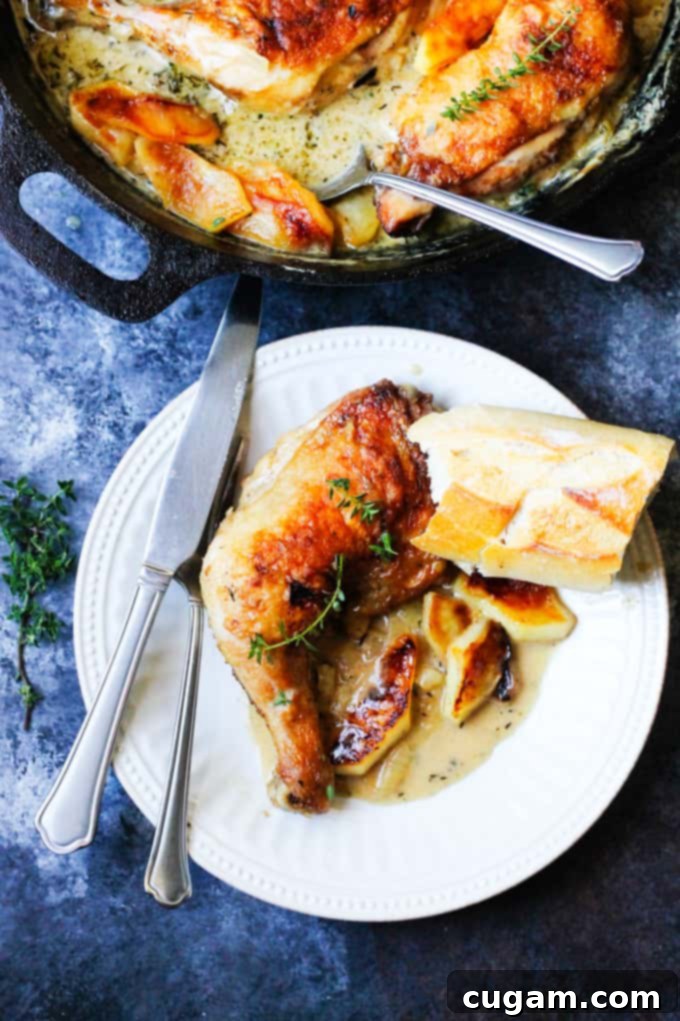
Storing and Freezing Your Chicken Normandy
One of the beauties of Chicken Normandy is its ability to be prepared ahead of time or to provide delicious leftovers. You can store this chicken in an airtight container in the refrigerator for up to 3 days. Reheating is straightforward: for individual portions, simply use your microwave for 2-3 minutes, or for larger quantities, place it in an oven preheated to 350°F (175°C) for approximately 15 minutes, until it’s warmed through and bubbling. Make sure the chicken reaches an internal temperature of 165°F (74°C).
For longer storage, you can also freeze it in individual portions in freezer-safe containers for up to 3 months. To enjoy, defrost it overnight in the refrigerator, then transfer it to a 350°F (175°C) oven for 20-30 minutes, or until thoroughly heated. Freezing the sauce separately from the chicken can sometimes help preserve the texture of the chicken, but it generally holds up well together.
How to Serve This Elegant Chicken à la Normande
The sauce is arguably one of the stars of this Chicken Normandy, featuring a sublime blend of caramelized onions, rich brandy, tart apple cider, sharp Dijon mustard, and velvety cream. Its flavor is so incredibly captivating that you’ll want to savor every last drop. Therefore, I wholeheartedly recommend serving this dish with a crusty, fresh bread, such as a classic baguette or a rustic round. This allows you and your guests to delightfuly soak up every bit of that extraordinary sauce.
Beyond bread, this versatile dish pairs wonderfully with a variety of sides. Creamy polenta or delicate egg noodles would be excellent choices, providing a comforting base for the sauce. However, my personal top recommendations are either mashed potatoes with brown butter, which offer a rich and fluffy canvas, or the elegant Boulangere Potatoes, for a more rustic and savory option. For a lighter accompaniment, consider a simple green salad with a vinaigrette to cut through the richness, or some steamed green beans tossed with a knob of butter.
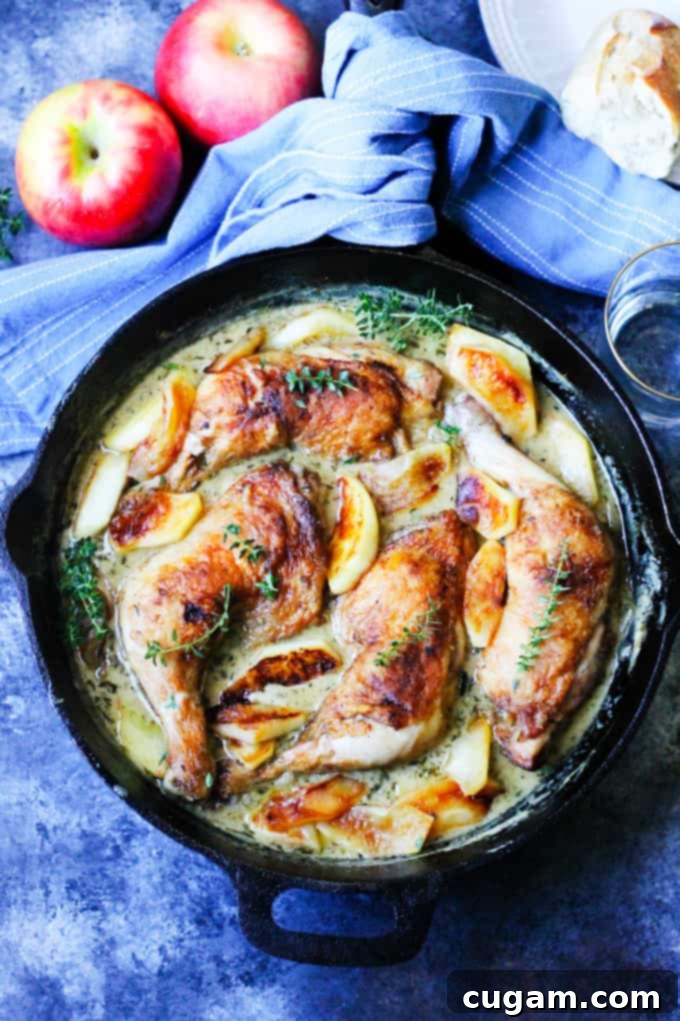
Other Classic French Recipes to Explore:
- Perfect French Crepes
- French Salad with Brie and Pears
- Classic French Salad Dressing
- Pan Bagnat (Authentic French Sandwich)
- Classic Croque Monsieur
- Pan-Fried Cod with Meuniere Sauce
More Popular Chicken Recipes to Try:
- Oven Roasted Chicken Legs (Thighs and Drumsticks)
- Slow Roasted Chicken Leg Quarters with Crispy Skin
- Dijon Meyer Lemon Chicken
- Hearty Hungarian Chicken Paprikash
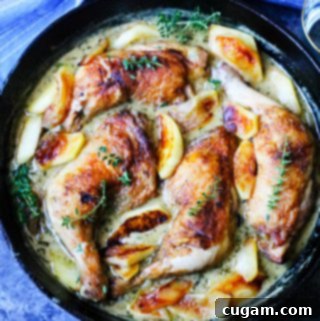
Chicken Normandy (Chicken Legs Braised in Apple Cider & Brandy)
Print
Pin
Rate
Ingredients
- 2 tbsp Unsalted Butter to fry apples
- 2 whole Apples* peeled, cored, and sliced (e.g., Honeycrisp or Granny Smith)
- 4 Whole Chicken Leg Quarters
- pinch of Salt to season each chicken leg
- 2 tbsp Unsalted Butter to sear the chicken legs (or as needed)
- 1 Yellow Onion medium size, thinly sliced
- 1 clove Garlic minced
- 1 teaspoon Dry Thyme
- 1/2 cup Brandy (ideally Apple Brandy or Calvados)
- 1.5 cups Apple Cider (unsweetened, cloudy apple juice – NOT vinegar)
- 1/2 cup Heavy Cream
- 1 tbsp Dijon Mustard
- 2 sprigs Fresh Thyme chopped, for garnish
- Salt & Freshly Ground Black Pepper to taste
Instructions
-
1. Fry the apples: Peel, quarter, remove seeds, and slice the apples. Heat 2 tablespoons of butter in a large, oven-safe skillet over medium heat. Add the apple slices in one layer and fry them until golden brown, flipping a few times. This takes about 5-7 minutes. Once cooked, remove the apple slices and set them aside.
-
2. Sear the Chicken: Add another 2 tablespoons of butter to the same skillet (or as needed if using leaner cuts). Season the chicken leg quarters generously with salt and pepper on both sides, then lightly sprinkle with flour. Sear the chicken in the hot pan for 5-7 minutes per side, until the skin is crispy and golden brown. Remove the seared chicken from the pan and set it aside with the apples.
-
3. Prepare the braising liquid: Preheat your oven to 375ºF (190ºC). To the same pan (adding butter if necessary for leaner chicken), add the sliced onions. Sauté the onions over medium heat for approximately 5-7 minutes until softened. Add the minced garlic and dry thyme, and cook for another minute until fragrant. Deglaze the pan by pouring in the brandy and scraping up any browned bits from the bottom. Cook until about half of the brandy has evaporated (about 2-3 minutes). Then, add the apple cider (cloudy apple juice) and cook for about 5 minutes, allowing the liquid to reduce slightly.
-
4. Braise the chicken: Return the seared chicken (skin side up) to the skillet, nestling it into the braising liquid. Cover the pan tightly with a lid or foil and transfer it to the hot oven. Bake the chicken for 30 minutes, or until the internal temperature reaches 165°F (74°C). Carefully remove the pan from the oven using heavy-duty oven mitts. Remember the handle will be very hot.
-
5. Finish the sauce: Carefully remove the chicken from the skillet and place it on a clean plate. Return the skillet to the stovetop over medium heat. Stir in the heavy cream, then the Dijon mustard, mixing well. Cook for about 5 minutes, stirring occasionally, until the sauce thickens to your desired consistency. Add the fried apples and chopped fresh thyme back into the skillet. Gently return the chicken pieces to the skillet, spooning some of the rich sauce over them to coat.
-
6. Serve: To serve, spoon a generous amount of the velvety sauce, along with onions and apples, onto each plate. Place a succulent chicken leg quarter on top of the sauce. Enjoy immediately with your preferred side dish!
Notes
- For this recipe, it’s best to use firm, somewhat tart apples that will hold their shape well during frying and braising. Honeycrisp apples are an excellent choice, as are Granny Smith for a slightly tangier flavor profile. Avoid apples that become mushy when cooked.
Nutrition
Read more about the author Edyta here or follow Eating European on social media for more culinary inspiration: Facebook, Instagram, Pinterest, and Twitter.
